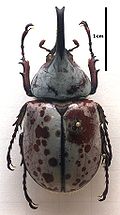| Dynastes | |
|---|---|
 | |
| Dynastes grantii | |
| Scientific classification | |
| Kingdom: | Animalia |
| Phylum: | Arthropoda |
| Class: | Insecta |
| Order: | Coleoptera |
| Suborder: | Polyphaga |
| Infraorder: | Scarabaeiformia |
| Family: | Scarabaeidae |
| Tribe: | Dynastini |
| Genus: | Dynastes MacLeay, 1819 |
| Synonyms | |
| |
Dynastes is a genus of large beetles belonging to the family Scarabaeidae. They occur in the Nearctic realm and in the Neotropical realm, from the United States to Brazil; [1] [2] four North American species (including Mexico), three with distributions extending from Central America either north or south, and two species endemic to South America. [2]















